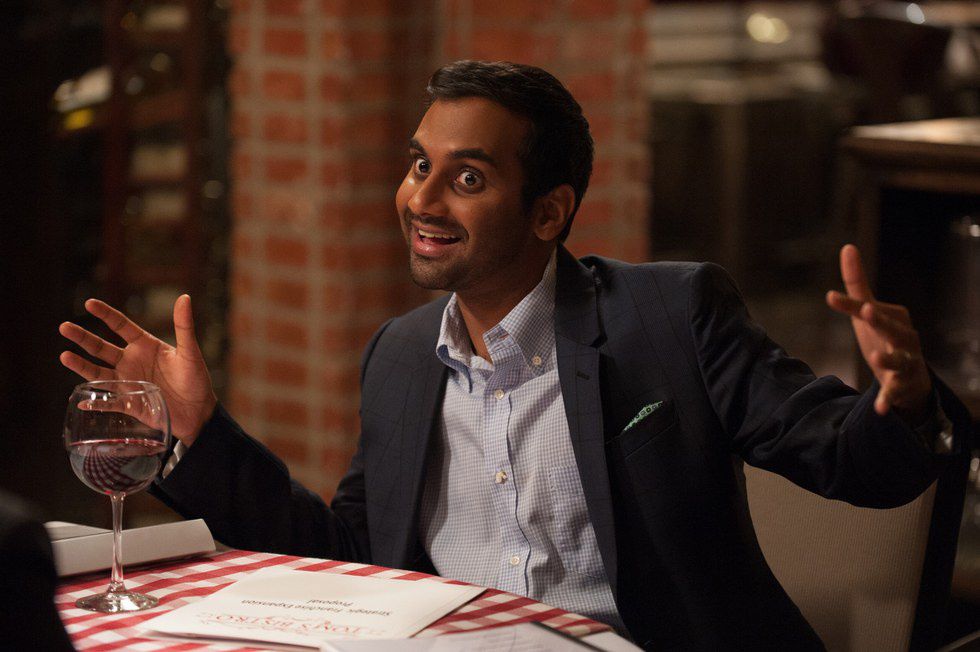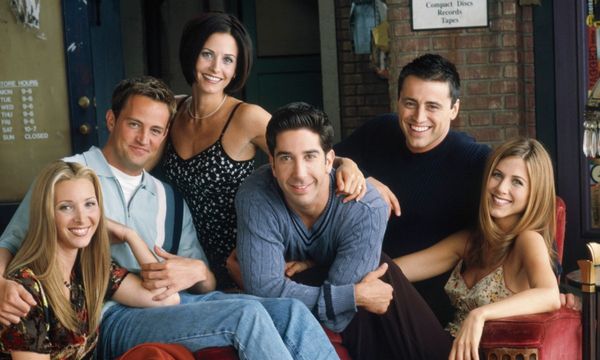Recently, I wrote a really interesting final paper for my sociology class. I’d like to share some of the most important points that I discovered in my analysis. My assignment was simple: choose a clip of media and discuss how it treats race. I chose “Master of None” because it’s a favorite show of mine, and I think it does a really insightful job at provoking thought on treatment of Indian men on television.
Season 1, episode 4 of Aziz Ansari’s new Netflix Sitcom special, Master of None, is entitled “Indians on TV.” In the opening ten minutes of the episode, there is a sequence of clips from older TV shows, movies, and music videos that feature Indian characters. This sequence sets up the major thematic of the episode: to reveal and critique the offensive and stereotypical portrayal of Indian men on television, and the prejudices and biases that affect employment of Indian actors. While Netflix is generally aimed at a millennial audience, typically more educated on PC issues than older generations, and while this show was released in 2015, this episode of Master of None nonetheless begs commentary on a type of discrimination, towards Indian actors, that is often indiscernible to the public eye.
This episode centers around creator Aziz Ansari’s character Dev auditioning for TV roles. In his first audition of the episode, Dev is rejected when he refuses to read the scene with an Indian accent. He then discusses with his friend Ravi his frustrations concerning the stereotypical roles offered to Indian men. When a TV producer slips up and emails a racist joke, Dev further realizes the extent to which Hollywood creates a hierarchy of race and normalizes whiteness on screen.
This episode conveys the message of how prominently Indian men are still associated with the dated and wildly inaccurate stereotypes of their ethnicity. When Dev is auditioning for the role of a Taxi driver and is asked to use an Indian accent, he tries to protest this choice. “It might be strange to play Gandhi and talk like I’m talking now.” The casting director responds that “I would argue that the same could be said of this cab driver.” This demonstrates the director’s view that it would be unrealistic to have a taxi driver who is not Indian, which wildly follows the stereotype of Indian men and does nothing to break this box around their identity.
The media relies on a prejudiced view of Indian men. Indian men, furthermore, are often objectified as weird and amusing, like the role of “Pradeep” in this episode, who “runs a convenience store [and] has a funny Indian accent.” As Dev laments, “so much of the stuff we go out for is stereotypes; cab driver, scientist, IT guy… why can’t there be a Pradeep, just once, who’s like an architect? Or he designs mittens? Or does one of the jobs Bradley Cooper’s characters do in movies?”
What’s important to realize here is that Bradley Cooper is white, and therefore has a wider range of socially accepted roles to play. In observing the practices of Hollywood film casting, this hierarchy of race becomes more clear. In “Indians on TV” when Dev is offended by a racist joke from a leaked email that reads: “’ let’s meet them both and see who can curry our favor,’” the producer, Jerry Danvers, insists that there cannot be two Indian men on his TV show. Dev explains to his friends that “people don’t get that fired up about racist Asian or Indian stuff…you only really risk starting a brouhaha if you say something bad about black people or gay people…if Paula Deen had said, ‘I don’t serve Indian people,’ no one would really care.”
Dev illuminates this constructed hierarchy between people of color. While people of color, as one entity, are generally underprivileged and underrepresented in media, Dev outlines how justice to Asian-Americans specifically is still ignored, and Asian-American representation is still considered less important. This is particularly striking in comparison with African-Americans, for example. “Black people just got to ‘there can be two’ status,” Dev says, “[and] even then though there can’t be three, ‘cuz then it’s like a ‘black show.’”
Dev points out that once a show has multiple people of color, it becomes “niche,” and it suddenly is presented as a film for only a certain group of minorities or people of color. This “others” any race or ethnicity besides white and Caucasian, and acts as evidence of the normalizing of whiteness that Aziz Ansari highlights in “Indians on TV.”
When Dev interrogates Jerry Danvers on his racism, Danvers responds that “everyone’s gonna’ think it’s an Indian show…it wouldn’t be as relatable to a large mainstream audience.” Dev counters that “you would never say that about a show with two white people,”
This proves whiteness as the cultural norm because only when there are actors of color is race actually considered an important factor in media. Only when there are non-white actors is a film considered something that might not be enjoyable for a mass audience. Danvers says, in response to representing Indian men on television, that “we’re just not at that point.”
This emphasizes American media’s need to “baby-step” changes that display anything other than normative whiteness. By excessively relying on labels of constructed racial identities, TV producers can slowly infiltrate people of color into the media and thus “appease” the normative whiteness, in a sense, by offering people of color as “token” individuals, and as others.
For example, Dev says that increasingly prominent Indian actors are “like set decoration. We’re not the ones doing the main stuff.” This presents normative whiteness because, even when Indian actors are cast on TV, they are cast as inferior figures to the white people.
Finally, at the climatic end of the episode, when Dev has the possibility to finally be cast on a TV show that features two Indian men, the new TV producer, a white woman, designs a show centered around an Indian man, “born and raised in America and totally assimilated,” and his visiting cousin, born in India and a “fish out of water.” While this producer believes herself to be creating something groundbreaking and diverse, she too is submerged in her world of normative whiteness because, despite her attempts, her creation still places Indian men in stereotypical, offensive, and othering roles.
Dev also displays to his friends how thoroughly their Indian heritage has been, unknowingly and unwillingly, whitewashed on screen. “At least they’re actually getting Indian actors to do those roles now and not going the, uh, short circuit 2 route,” Dev says, “they got a white guy to play an Indian guy…they used brown-face makeup…they got a real robot and a fake Indian.”
Dev’s friend Ravi further emphasizes the hegemonic power of the film industry when he says, “I just can’t wait for that; I gotta work.” While Ravi would like to audition for only roles that respect his Indian identity, the prejudiced practices of the system are too far ingrained to wait for. Ravi must subject himself to these roles, despite how problematic they may be, in order to make a living.
As Dev explores how his employment and representation are affected by normative whiteness and a hierarchical structure among different races, it’s clear to see how the racialization of bodies creates boundaries and division lines between equal human beings.
So, in sum, in Master of None, Azis Ansari and his character Dev breech important conversations about the flaws in American Media representation and the need to break down the constructed inequalities among human bodies.
This paper topic was fascinating and mind-opening to me and I hope my analysis will inspire some of you to watch this show, because this episode especially, is really important.
Happy Netflix-Binging and Happy Holidays.



















